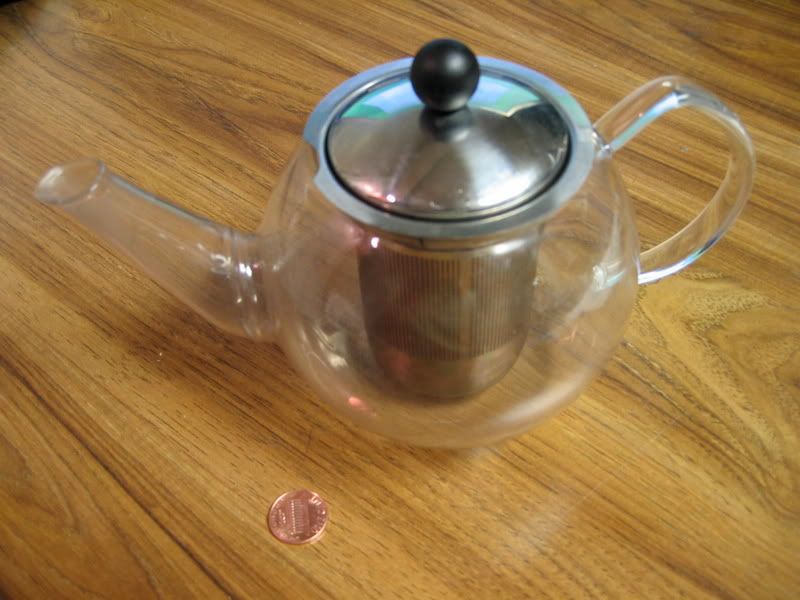

Unfortunately, as some of you may know, Jenaer Glas is no longer in existence. Their parent company discontinued the Jenaer Glas line of products due to a decline in demand and an increase in foreign imports (read the full article here.). You can still find some of their glassware at stores like Adagio Teas, but their supplies are limited. On a lighter note, Bodum is alive and well, and continues to make beautiful and functional teaware.
So, let's start off with Bodum's 2-cup "Shin Cha" teapot. Made of borosilicate glass, the same glass used in lab equipment, this teapot is strong and can withstand rapid changes in temperature. It also employs Bodum's tea press design, which is remarkably handy.
The tea press, which is featured on many Bodum teapots, is a very convenient design. I was a bit hesitant to buy one of Bodum's teapots at first, as their website is bad at explaining exactly how it works. So, for you curious folks, here you go. While the tea is brewing, the plunger remains in the up position (shown here).
 At this point, the plunger is not doing anything, so everything functions just like a normal teapot. When you are ready to halt the steeping process, you simply press down on the plunger. This confines the leaves in the bottom of the infuser, and seals them (more or less) from the outside liquid, preventing them from steeping any further.
At this point, the plunger is not doing anything, so everything functions just like a normal teapot. When you are ready to halt the steeping process, you simply press down on the plunger. This confines the leaves in the bottom of the infuser, and seals them (more or less) from the outside liquid, preventing them from steeping any further. One very important thing about this infuser is that there are no holes below about 3/4 of an inch from the bottom (see picture). The benefit of this is that the tea is not squeezed into the liquid, and thus does not release any nasty bitterness into the brew.
 The downside of this is that your tea leaves do not see as much water, and it could be argued that they do not brew as well, though I have not noticed it. Also, unlike coffee presses, which have large holes in the plungers, Bodum's tea press has just one small one, which exists solely as a pressure release for when the plunger is depressed. Oh, and don't worry, the plunger didn't look like that when I first got it-- it has seen quite a bit of use.
The downside of this is that your tea leaves do not see as much water, and it could be argued that they do not brew as well, though I have not noticed it. Also, unlike coffee presses, which have large holes in the plungers, Bodum's tea press has just one small one, which exists solely as a pressure release for when the plunger is depressed. Oh, and don't worry, the plunger didn't look like that when I first got it-- it has seen quite a bit of use.Anyway, I find the tea press mechanism to work quite well, and I have not noticed any dramatic alteration in the taste of my tea.
 I have noticed, however, that over time, tea left in the pot will get darker if the infuser + leaves are are also left in. If this becomes too much of a problem, just remove the infuser and problem solved.
I have noticed, however, that over time, tea left in the pot will get darker if the infuser + leaves are are also left in. If this becomes too much of a problem, just remove the infuser and problem solved.This teapot is not only functional, but quite attractive as well. That is, until you put anything in it. Okay, that may be a bit of an exaggeration, but this will definitely get dirty. It's not too much of a problem to wipe it down every now and then, but you will certainly have to do so much more for a glass teapot than one of a different material.
Overall, I'd give the Bodum 2-cup "Shin Cha" teapot an 8/10. Functional, but not perfectly so, and attractive, as long as you take good care of it.
Obviously there is not as much to mention about this teacup as it is, after all, just a teacup. Still, I'd like to mention that it is made of borosilicate glass, just like the Bodum teapot from earlier. It's strange, because it almost feels like plastic, even though it looks just like glass.
 It's definitely not plastic, but it still feels very sturdy, unlike a lot of other glassware out there. Also, it holds just the right amount for a cup of black tea. Unfortunately it suffers from the same tendency to get dirty as the Bodum teapot, but I still recommend getting a hold of some pieces from Jenaer Glas if you still can.
It's definitely not plastic, but it still feels very sturdy, unlike a lot of other glassware out there. Also, it holds just the right amount for a cup of black tea. Unfortunately it suffers from the same tendency to get dirty as the Bodum teapot, but I still recommend getting a hold of some pieces from Jenaer Glas if you still can.Jenaer Glas gets a posthumous 9.5/10 for its gorgeous yet durable teaware.


No comments:
Post a Comment
Note: Only a member of this blog may post a comment.